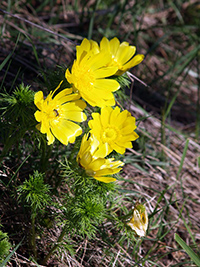Table of Contents
The yellow adonis plant is a prototype of those medicinal herbs whose toxic dose is quite close to the therapeutic one. This means that the plant must be cautiously administered.

Healing Properties and Warning
All parts of the plant contain two types of cardiotonic glycosides, similar to those of the foxglove plant: adonidosis and adonivernosid. The plant has cardiotonic (increases the strength of heart contractions), coronary artery dilating (fights against angina pectoris), diuretic, and mildly sedative properties. Thus, under medical supervision, it is a highly valued remedy for diverse heart afflictions.
Unlike foxglove glycosides, which are widely used as cardiotonic, those of the yellow adonis do not accumulate in the body (they are quickly eliminated via urine). Therefore, it is helpful to temporarily substitute foxglove, especially in long-term treatment.
WARNING! In high doses, it provokes nausea, vomiting, and diarrhea. Because of its toxicity and difficulty of dosage, only physicians can prescribe it and control its effects.

Yellow Adonis Scientific Facts
- French: Adonis du Printemps.
- Spanish: Adonis vernal.
- Environment: Central and Southern Europe. It is a rare plant that prefers south-facing rocky and calcareous soils.
- Description: A plant of the Ranunculaceae family, it grows from 10 to 40 cm high. It has finely divided leaves and big, yellow flowers that open with sunlight.
- Parts of the plant used medicinally: The flower clusters.

How to use Yellow Adonis
- Infusion with eight grams of flower clusters per 200 ml of water at 60 degrees Celsius, steeping until cold. That usual dose is from four to six tablespoonfuls daily.
Frequently Asked Question
What specific heart conditions might this plant benefit?
Studies suggest yellow adonis may help manage chronic heart failure. It appears to improve heart function by regulating electrolytes and contractility. However, it should not be used as a sole therapy.
Can the plant help regulate blood pressure?
Some research indicates yellow adonis may have mild blood pressure-lowering effects.
Are there cognitive benefits associated with this plant?
limited research suggests yellow adonis might improve cognitive function in patients with CHF (chronic heart failure). However, more research is required to determine its efficacy for cognitive enhancement in the general population.
Can the plant interact with other medications?
Yellow adonis can interact with certain medications, including diuretics, blood pressure medications, and digoxin. If you take any medicines, it’s crucial to consult a healthcare professional before using this plant.
Are there side effects associated with the plant’s use?
Yellow adonis may cause side effects like stomach upset, diarrhea, and skin rash. It’s not recommended for pregnant or breastfeeding women.
Is yellow adonis safe for long-term use?
The safety of long-term use is not fully established. It’s advisable to consult a healthcare professional regarding appropriate usage duration.
Can it be used topically?
While some topical uses are mentioned in historical contexts, insufficient research confirms their safety or efficacy.
Is yellow adonis considered a stimulant?
No, it is not typically classified as a stimulant. Its potential benefits lie in regulating heart function and blood pressure.
How does it compare to other herbs for heart health?
Several herbs like hawthorn and garlic have shown promise in supporting heart health. However, each herb has unique properties and potential benefits. Consulting a healthcare professional can help determine the most suitable option for individual needs.
Are there any ongoing clinical trials on yellow adonis?
No significant clinical trials are listed on https://clinicaltrials.gov/, specifically investigating yellow adonis. However, research into natural products for heart health is ongoing.
DISCLAIMER: All content on this website is presented solely for educational and informational objectives. Do not rely on the information provided as a replacement for advice, diagnosis, or treatment from a qualified medical expert. If you are pregnant, nursing, or have any preexisting medical concerns, talk to your doctor before using any herbal or natural medicines.
REFERENCES
- George D. Pamplona-Roger, M.D. “Encyclopedia of Medicinal Plants.” George D. Pamplona-Roger, M.D. Encyclopedia of Medicinal Plants. Ed. Francesc X. Gelabert. Vols. 1 San Fernando de Henares: Editorial Safeliz, 2000. 215. Print.
- National Institutes of Health. (2020, December). Adonis vernalis. https://pubmed.ncbi.nlm.nih.gov/21447342/
- Natural Medicines Database. (2020). Adonis vernalis. https://www.shi.ch/fileadmin/user_upload/adonis_vernalis.pdf
- Zhang, Y., Liu, J., & Zhou, L. (2017). The effect of Adonis Vernalis glycosides on cognitive impairment in patients with chronic heart failure. International journal of clinical and experimental medicine, 10(5), 8229.https://journals.sagepub.com/doi/abs/10.1177/11795735221123896
- WebMD. (2020). Adonis vernalis. https://www.shi.ch/fileadmin/user_upload/adonis_vernalis.pdf
- Mayo Clinic. (2020). Yellow adonis (Adonis vernalis). https://www.picturethisai.com/wiki/Geum_aleppicum.html
- Memorial Sloan Kettering Cancer Center. (2021). Adonis vernalis. https://www.mskcc.org/cancer-care/diagnosis-treatment/symptom-management/integrative-medicine/herbs/search?%3Bop=Go&_escaped_fragment_=&keys=breast%20cancer&letter=&letters=&page=10
- Examine.com. (2022). Adonis vernalis. https://examine.com/research-feed/study/w9kjz0
- National Center for Complementary and Integrative Health. (2020). Herbs for heart health. https://www.nccih.nih.gov/health
